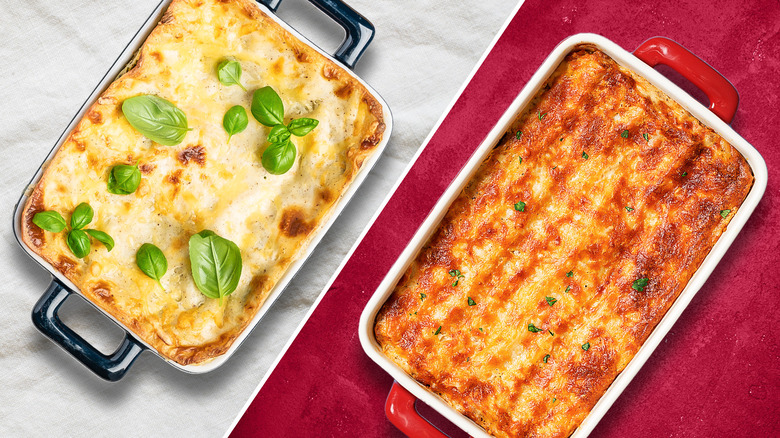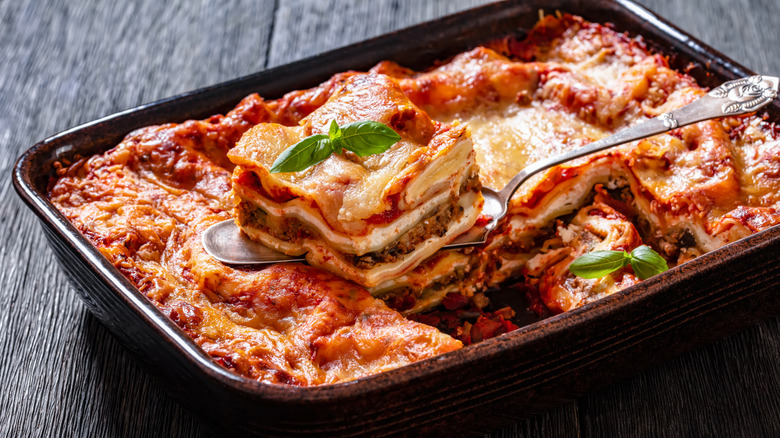What Makes White Lasagna Different From Red?
Italy is a country of amazing regional culinary diversity, and even within more specific Italian dishes, you can get recipes as different as white and red lasagna. The layered pasta is one of the iconic foods of the Mediterranean country but, in the United States, we tend to think of "traditional" lasagna in one way: the tomato sauce and cheese version, usually with ground meat. But like many dishes we think of as Italian, that's an American version of the dish.
The origins of lasagna go back hundreds and maybe even thousands of years. It's specific birthplace is unclear, with the term being an evolution of either the Latin word "lasanum," which means "cooking pot," or another term for flat bread coming from Greece: "laganum." Whichever gave us the modern term, there is evidence that dishes similar to lasagna were consumed in ancient Rome. One of the oldest surviving cookbooks in the world by the Roman writer Apicius even contains a recipe that layers bread, meat, and cheese.
The modern form of lasagna appeared in the Middle Ages in the region of Emilia-Romagna, and over those hundreds of years, it has evolved into dozens of different local variations, some with red sauce but many without. Not all lasagna would be either white or red, like the Ligurian lasagna alla Genovese, which makes use of the preferred regional sauce: pesto. White lasagna, like red, is mostly classified by the sauce, but there are just as many filling and flavor variations in both.
What is red lasagna?
Red lasagna is any lasagna recipe that includes a red sauce element, usually with tomato. The classic American-style lasagna falls into this category, so it's what most people in the U.S. think of as lasagna, but some of the most famous red lasagnas in Italy are quite different from it. The American version evolved from a similar regional style in Naples and Southern Italy, where most Italian-Americans immigrated from. There are far more lasagna recipes all over the country, even if you just include the lasagnas made with tomato sauce.
American red lasagna uses a mixture of mozzarella, ricotta, and meat, but none of those ingredients are universal in the style. The most famous red lasagna in Italy is probably lasagna Bolognese, which is from Emilia-Romagna and one of the earliest versions of lasagna. Lasagna Bolognese uses the namesake meat sauce and gets its creamy, melty texture from bechamel and Parmigiano Reggiano cheese instead of mozzarella. The style actually has little to no tomato in the meat sauce. Even the Neapolitan recipe the America version evolved from is different in Italy, as Lasagna alla Napoletana uses whole meatballs instead of meat sauce. There are also more tomato-heavy versions like Sicilian Lasagna alla Norma, which layers in eggplant and basil. Red lasagna works with almost any ingredient that would make a good pasta sauce, like Italian sausage or puttanesca with olives and anchovies.
What is white lasagna?
White lasagna drops the tomatoes (or mostly does) in favor of a creamy white sauce, usually based on bechamel. The bechamel is made in the classic French fashion using a roux and milk and can be flavored with grated cheese like Parmigiano Reggiano but isn't always. Dropping the acidity from the tomatoes makes white lasagna an even richer and more luscious dish than red lasagna, with or without extra cheese. Besides the sauce, it is made in much the same way as red lasagna, but the creamy sauce pairs especially well with vegetables, as opposed to the heartier meat fillings of red lasagna. If meat is added, white lasagna really benefits from strong salty flavors that can cut through the fatty taste, so cured meats like pancetta or flavorful crumbled sausage are popular.
And while white lasagna may seem like a secondary style to red in the U.S., it's anything but in Italy. Lasagna predates the arrival of tomatoes in Italy, and the earliest Medieval versions used a broth-based sauce combined with flour, eggs, milk, and meat. Modern veggie-forward styles of white lasagna often use spinach, but regional versions in Italy show the versatility of the style. Examples include Taleggio Lasagna from Northern Italy, which uses a taleggio cheese sauce with shallots, radicchio, and mushrooms, or Vincisgrassi made with bechamel, mushrooms, and prosciutto. So even if it isn't something you're used to, there are a huge variety of amazing white lasagna recipes to sample for anyone's taste.


